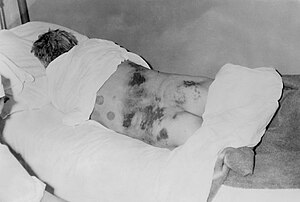Crimean-Congo Hemorrhagic Fever virus
| Crimean–Congo hemorrhagic fever | |
|---|---|
 |
|
| Male diagnosed with Crimean-Congo hemorrhagic fever, 1969 | |
| Specialty | Infectious disease |
| Symptoms | Fever, muscle pains, headache, vomiting, diarrhea, bleeding into the skin |
| Complications | Liver failure |
| Usual onset | Rapid |
| Duration | Two weeks |
| Diagnostic method | Detecting antibodies, the virus's RNA, or the virus itself |
| Similar conditions | Dengue fever, Q fever |
| Treatment | Supportive care, ribavirin |
| Prognosis | Risk of death ~ 25% |
| Crimean–Congo hemorrhagic fever | |
|---|---|
| Virus classification | |
| Group: | Group V ((−)ssRNA) |
| Order: | Unassigned |
| Family: | Bunyaviridae |
| Genus: | Nairovirus |
| Species: | Crimean-Congo hemorrhagic fever virus |
| Classification | |
|---|---|
| External resources |
Crimean–Congo hemorrhagic fever (CCHF) is a viral disease. Symptoms may include fever, muscle pains, headache, vomiting, diarrhea, and bleeding into the skin. Onset of symptoms is less than two weeks following exposure. Complications may include liver failure. In those who survive, recovery generally occurs around two weeks after onset.
The CCHF virus is typically spread by tick bites or contact with carrying the disease. Those affected are often farmers or work in slaughterhouses. It can also spread between people via body fluids. Diagnosis is by detecting antibodies, the virus's RNA, or the virus itself. It is a type of viral hemorrhagic fever.
Prevention involves avoiding tick bites. A vaccine is not commercially available. Treatment is typically with supportive care. The medication ribavirin may also help.
It occurs in Africa, the Balkans, the Middle East, and Asia. Often it occurs in outbreaks. In 2013 Iran, Russia, Turkey, and Uzbekistan documented more than fifty cases. The risk of death among those affected is between 10 and 40%. It was first detected in the 1940s.
The illness in humans is a severe form of hemorrhagic fever. Typically, after a 1–3 day incubation period following a tick bite or 5–6 days after exposure to infected blood or tissues, flu-like symptoms appear, which may resolve after one week. In up to 75% of cases, signs of bleeding can appear within 3–5 days of the onset of illness in case of bad containment of the first symptoms: mood instability, , mental confusion and throat petechiae; and soon after nosebleeds, vomiting, and black stools. The liver becomes swollen and painful. Disseminated intravascular coagulation may occur, as well as acute kidney failure, shock, and sometimes acute respiratory distress syndrome. People usually begin to recover after 9–10 days first symptoms appeared. Up to 30% of infected people die by the end of the second week of illness.
...
Wikipedia
